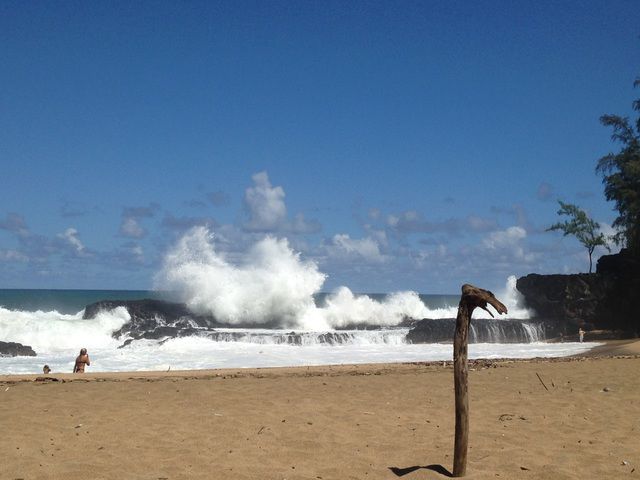Change in swells comes with the change in seasons on Kauai, and last winter was an example of just how gnarly the waves can get — particularly on the island’s north-facing shores. Waves towering more than 40 feet in height
Change in swells comes with the change in seasons on Kauai, and last winter was an example of just how gnarly the waves can get — particularly on the island’s north-facing shores.
Waves towering more than 40 feet in height were reported regularly in 2015 and in early 2016 along the North Shore, with a few 60-foot faces rolling through. Experts are gearing up for another winter of giants.
“The North Shores of our islands are the most dangerous in the world (in the winter)”, said Chip Fletcher, coastal geologist and professor at the University of Hawaii at Manoa. “These waves, when they run up on the beach, are like fire hoses and they’ll rip your feet right out from underneath you.”
The north and west shores are where the waves are biggest from September through May on Kauai, according to Randy Ortiz, training captain of the Kauai Ocean Safety Bureau.
At Lumahai Beach, for instance, which is located north of Hanalei on the way to Ke’e Beach, 30-foot waves generally turn the tranquil summer bay into a titanic — and dangerous — splash zone.
But it’s not just the monster waves that present a cause for worry. They also bring with them strong rip currents that could pull you straight out into the open ocean.
The most dangerous beaches for rip currents this time of year are Lumahi, Anini, Polihale and Hanakapiai — in that order, according to Ortiz.
“Most Kauai beaches during high surf have dangerous rip currents, so we advise beachgoers to be cautious during the winter months at all beaches, both guarded and unguarded,” Ortiz said.
That’s because the big waves travel in groups of three to six and each time a set comes in, it pushes the water further up the coast. That creates a high sea level on the coastline and after the waves recede, the water finds its way back to the ocean through channels in the rock.
“They create what are known as topographically fixed rip currents,” Fletcher said. “At certain beaches they occur in the same place every year because the channel in the reef is carved into the rock.”
That’s not the only kind of rip current, Fletcher said, but the fixed rip currents “tend to be the most powerful.”
And these currents aren’t always easy to spot.
“Initially you might look at the surf zone and you might not see the rips,” Fletcher said. “But look at the surface of the ocean, you can tell the water is flowing — it gets these lineations.”
The flowing water most likely will have a lot of sand and other sediment suspended in it, Fletcher said, so look for a stream of dirty water that flows out to sea and ends in a cloud once the rip is over.
“At the place where it ends, there’s a mushroom cloud of sand that settles and creates a sand bar,” Fletcher said.
Sometimes experienced surfers use these rip currents to carry them out to the waves from shore, but Fletcher said that’s only recommended for highly experienced swimmers.
“They can be useful, but they can be deadly if you’re not used to the ocean and you’re not a strong swimmer,” Fletcher said. “Suddenly this water is dragging you out, and you can’t swim against it.”
The key to escaping a rip current is to swim sideways, out of the current’s path, but that doesn’t mean that you’d be swimming to safety.
“If you swim sideways, the chances are that the next set of waves has arrived (once you’ve escaped the rip current) and you’re swimming right into the surf zone of the waves,” Fletcher said.
Beachgoers should only swim at lifeguarded beaches and should always chat with the lifeguard on duty before entering the water, especially visitors that don’t have experience with Kauai beaches.
“The lifeguard can point out where the rip currents are,” Fletcher said. “It’s critically important for inexperienced swimmers to tell the lifeguard ‘I’m not experienced in the ocean, please give me some advice.’ The lifeguard will fill you in on what’s safe and what isn’t safe.”
The combination of the rip currents and large waves can also completely change the look and condition of some of Kauai’s beaches.
“One of the things that happens with these waves is that their energy is so strong, they actually raise the sea level along the coast a few inches and they produce seasonal erosion of beaches,” Fletcher said. “The beach will change its configuration as the sand shifts away from the direction the waves are coming.”



